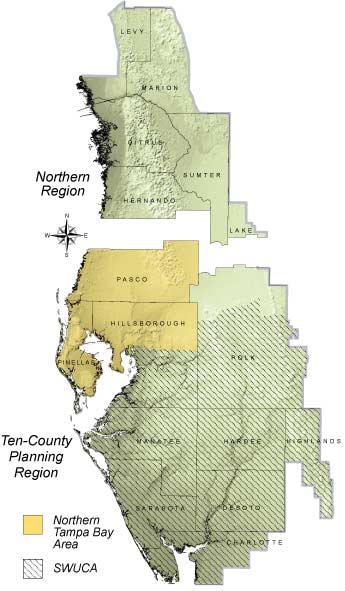
District scientists and planners recently completed an updated Regional Water Supply Plan to assess projected water demands and identify potential sources of water to meet those demands through the year 2025. The Regional Water Supply Plan was first developed in 2001 and is periodically revised based on updated information such as the demand for water.
The plan, which was created for a ten-county area from Pasco County to Charlotte County, also identifies the associated costs for developing these sources and addresses the need to sustain water resources and the related natural systems.
The Regional Water Supply Plan builds upon a number of important regional water supply planning efforts the District has recently participated in, including the efforts of the Peace River/Manasota Regional Water Supply Authority, which includes Charlotte, DeSoto, Manatee and Sarasota counties and municipalities within the counties; and the Heartland Water Alliance, which includes DeSoto, Hardee, Highlands and Polk counties and municipalities within the counties. It also builds on recent cooperative efforts with Tampa Bay Water and its member governments, including Hillsborough, Pasco and Pinellas counties and the cities of Tampa, St. Petersburg and New Port Richey.
The District’s Governing Board approved the updated Regional Water Supply Plan after a public review process that included three public workshops to allow local governments, citizens and other water users an opportunity to contribute. The plan was also discussed during two Governing Board meetings. The District’s standing advisory committees, which include public supply, agricultural, industrial, green industry and environmental, also reviewed the updated plan. District staff worked with the neighboring water management districts during the process because the St. Johns River and South Florida water management districts are also preparing regional water supply plans for areas adjacent to the District’s planning region.
A water supply plan is not yet needed for the northern counties within the District because the area is not experiencing regional impacts to water resources. However, while the northern region is not part of the 2006 plan, the District is working with local governments, the Withlacoochee Regional Water Supply Authority and the St. Johns River Water Management District on water supply plans to address the region’s needs.
DEMAND
As part of the plan, water supply demand is projected for agricultural, industrial/commercial, public supply and recreation/aesthetic use sectors for each of the ten counties within the planning region. An additional water-use category, environmental restoration, comprises new or existing quantities needed to restore minimum flows and levels (MFLs) of impacted natural systems.
A minimum flow or level is the limit at which further water withdrawals will cause significant harm to the water resources and/or environment. The District Governing Board sets these limits as part of achieving a balance between meeting human water needs and those of Florida’s natural systems.
The agricultural sector evidenced a major change in demand for water since the 2001 plan. The water demands of agriculture dropped 33 million gallons per day (mgd), based on average use identified in a 2000 study. The main reason for the decline in demand is a substantial loss in citrus acreage as population growth spurs associated urban development on former citrus groves. The reduction is also due to the reduced permitted quantities that resulted from the District rule changes to the Southern Water Use Caution Area, which includes 5,000 square miles in all or part of the eight counties in the District’s southern region.
Despite a decrease in demand for the agriculture sector, projections show that approximately 409 mgd of new water supply will need to be developed through 2025 to meet the demand of all sectors and restore MFLs for the impacted natural systems.
At least 50 percent of this additional demand will be met by projects that have been completed since 2000 or are under development.
FUNDING & PROJECTS
Another development since 2001 is the addition of Senate Bill 444, which was passed during the 2005 legislative session. The bill strengthens requirements for identifying and listing water supply projects. The bill also created the Water Protection and Sustainability Program that provides matching state funds for the construction of alternative water supply projects.
Funding from the Water Protection and Sustainability Program is being used on several alternative water supply projects that involve the increased use of reclaimed water, surface water and desalination.
One major, multiphased project is the Peace River/Manasota Regional Water Supply Authority Regional Expansion, which includes constructing a reservoir, adding increased water treatment plant capacity and extending the regional transmission system to areas of DeSoto County. This project is expected to be complete by 2009.
Another major multiphased project is the Tampa Bay Regional Reclaimed Water Project, which includes the addition of more than 50 miles of pipeline, an additional 12 million gallons of reclaimed water storage, pumping and treatment facilities and seasonal storage reservoirs. This project is expected to be complete by 2014.
CONSERVATION
A commitment to water conservation, along with vigorous planning and regional cooperation among governments, is needed to conquer the challenge of meeting growing water supply needs while also protecting the natural resources.
The District is actively involved in promoting conservation to all water users in all sectors — households, agriculture and industry.
The District cooperatively funds conservation projects with local governments. Since 1991, the District has assisted local utilities with the distribution of 224,637 ultra-low-volume toilets and 500,399 plumbing retrofit kits. This effort has led to a cumulative savings of 11.9 mgd.
The District promotes Florida-friendly landscaping and other outdoor conservation methods by supporting the Florida Yards & Neighborhoods Program and funding Community Education Grants and other projects.
Agricultural conservation and efficient water use is promoted through the cost-share reimbursement program known as Facilitating Agricultural Resource Management Systems (FARMS) program. The District, in cooperation with the Florida Department of Agriculture and Consumer Services, initiated the FARMS program in 2002.
Due to the efforts and partnerships like those described, planners hope to ensure ample water for needed uses in our region.
